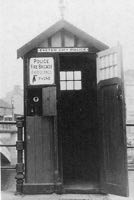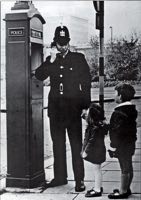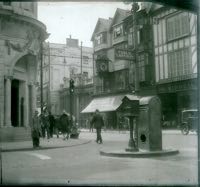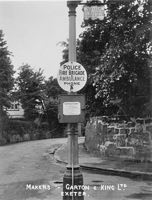
Police boxes and pillars
Contributed by three former Exeter City Police Officers–Sydney Rowsell, Peter Hinchliffe and Dick Passmore
Page updated 2nd October 2017
Following various methods of ‘policing’ the city, in 1836 Capt Hugh Cumming was appointed Superintendent, in charge of twenty-seven constables - a body that could, perhaps, be considered as Exeter’s first Police Force. His tenure was, however, brief, for in June, 1847, the Exeter City Council Watch Committee met at Guildhall to select a suitable number of men to form a new Police Force for the city. With over 150 applicants, the process took several hours, and Mr David Steele, of the Barnstaple Police, was appointed Superintendent in charge of the new Force of twenty-nine men. Thus began the new Exeter City Police Force–a Force that grew in stature and ability, to become recognised as one of the best Police Forces in the country.
Communication between the Police Station and Officers on various beats was at first by means of “conference points”, when Sergeants would meet Constables on their beats at appointed times, to ensure all was well.
In 1925 the City was newly-equipped with over a dozen Police boxes (the blue structures, shown left, frequently referred to these days as “Tardis” boxes), and a few triangular–shaped pillars. The idea of these was basically to provide a telephone for the public to contact any of the Emergency Services, and for the Police Station to be able to contact the nearest Police Officer by means of a flashing orange light at the top. (Bear in mind there were few private houses with telephones in 1925). The lights were operated from the Police Headquarters which, at that time, was situated in Waterbeer Street. The early wiring system could only cope with up to three pillars, so multiple sets of cables were required to operate all the pillars in the city. The control box at the police station was designed to operate a maximum of 33 pillars.
The Boxes were large and square, and of wooden construction, with enough space on one side for an Officer to sit inside and make notes, or have his meal break. On the left was a small door that opened for anyone to use the emergency direct telephone line. (Police boxes followed on from what were “Fire Points”, first installed in Glasgow in 1915, and then at other locations throughout the country).
Pillars were, at first, triangular in shape (see left), painted blue, with an orange light at the top, with one telephone for Police Officers, and another for use by the public. These remained until 1959, when the city’s Police Headquarters moved to new premises in Heavitree Road. The “Tardis” boxes were then removed from the streets, and all of the old pillars were replaced by modern, square pillars (see right), designed to house a telephone, and a lockable storage compartment below. The door of this compartment was hinged at the bottom, and when opened could be used by Officers as a “table” on which to rest when writing notes etc.
Throughout the life of Boxes and Pillars, the orange flashing light was a successful method of contacting an Officer. On occasions, if the Police Officer was in another street and out of sight of his box, it was not unknown for a passing member of the public to tell him “his light was flashing”.
In the 1970s, the advance of modern technology saw the advent of personal radios issued to all policemen. The pillars became surplus to requirement, and were subsequently removed, although one does still exist in the garden of a private residence in the city–as far as is known, the only one remaining in Exeter.
Beat working & pillars
In 1952 - a few years before the end of the Waterbeer Street Police Headquarters era - a new beat working scheme was introduced, with defined beat boundaries and telephone points available on each beat, although the telephone points were in much the same position as in 1925.
Obviously to police the city correctly and efficiently, Officers were required on duty 24 hours a day, seven days a week, as they are today. Until 1966, when Exeter City Police amalgamated with Devon County Police, and later became part of the Devon & Cornwall Constabulary, “Days” started at 8.30am on a Monday, and finished at 6pm on a Saturday. “Nights” were from 6pm to 8.30am, including Sundays and Bank Holidays. During those times, an eight-hour “day” shift could be either 6am until 2pm, or 8.30am until 4.30pm, 10am until 6pm, or 2pm until 10pm. Similarly, a night shift could be either 4.30pm until 12.30am, or 6pm until 2am, or 10pm until 6am.
The city was divided into areas–“beats”–and covered the whole of Exeter, including fairly isolated places such as Stoke Woods. Each beat had a defined boundary, and in many cases one side of a street could be a different beat area to the opposite side. It was the patrolling Officer’s duty to ensure ‘all was well’ on his beat during his particular shift, and he would report to his visiting Sergeant that this was so, or explain to him if there were problems. It was accepted that when a Sergeant ‘visited’, the Officer would tell him that everything was “all correct, Sergeant”–or, of course, otherwise. Heaven forbid that you said “all correct”, if the Sergeant had spotted something amiss a street or two away from where he had met you! (Readers may recall that television’s PC George Dixon, of fictional Dock Green, always greeted his Sergeant with “all correct, Sarge)
Each beat had at least one Pillar (often more than one) via which an Officer could be contacted. Naturally, there were frequent periods of several minutes in each shift when the Officer could be out of sight of a Pillar, but he was expected to make sure he worked his beat in such a way to keep an eye on his Pillar(s) should he be required for any incident. It would be considered “neglect of duty” if an Officer did not regularly check his pillar light.
Beats varied in size, and some had little in the way of residential areas or business premises (such as Stoke Woods, or Double Locks) and could be extremely quiet, with little ever happening. In such cases beats were often doubled up. For example, Higher Pennsylvania beat was usually joined with Lower Pennsylvania, which meant an area stretching from Cowley Road to Prince Charles Road, and from Wrefords Lane to Blackall Road–a huge area to cover; but that was an area of comparative quiet–until, it must be said, the arrival of students at the then newly approved University of Exeter! It has to be borne in mind that before the days of “Panda” cars, Police Officers had only their bicycles to go from one area to another. Thus an Officer could be at, say, Heavitree Bridge, and be required to deal with an incident in Topsham Road (because both were within his beat), meaning a good ten minutes on his bicycle before arriving at the scene! It was not usual for more than one Motor Patrol vehicle to be covering the city until later in the 1960s.
Many readers will doubtless recall the Pillars dotted around the city. Following the move of Police Headquarters to Heavitree Road, new Pillars were installed, although in one or two instances it was found that some could have been located in better, more visible, positions, and were moved. For example, the Pillar opposite Bradley Rowe School could not be seen from the Rifford Road side, and was moved further “up the hill” until it as visible from both sides.
The locations of the Police Pillars that existed in Exeter in 1966, when the Exeter City Police Force was sadly lost in the 1966 amalgamation with Devon Constabulary, is appended. County Constabularies did not use the Box or Pillar System, although following various amalgamations with Borough Forces (which did), some of their Pillars were retained for a while.
| MAIN STREET BEATS | |
| SIDWELL STREET | St Annes Chapel (two lights, one for Old Tiverton Rd., one or Blackboy Rd) |
| EASTGATE | Junction of Paris Street and High Street |
| HIGH STREET | Opposite Guildhall |
| FORE STREET, EXETER | Junction with King Street |
| EXE BRIDGE (demolished) | Bonhay Road - Exe Bridge Sub-Station |
| BUDDLE LANE | Junction Dunsford Road and Buddle Lane |
| OTHER BEAT AREAS | |
| THURLOW ROAD | Originally in Commins Road |
| POLSLOE BRIDGE | Junction Hamlin Lane |
| PINHOE ROAD | Whipton Sub-Station (since demolished, now Peel Close) |
| PRINCE CHARLES ROAD | Junction of Mount Pleasant Road |
| UNION ROAD | Junction Pennsylvania Road |
| COWLEY BRIDGE ROAD | Duryard entrance |
| CLOCK TOWER | Queen Street, junction New North Road |
| ST DAVID’S HILL | Outside Post Office (Red Cow) |
| PARIS STREET | Junction Western Way and Heavitree Road |
| FORE STREET, HEAVITREE | Sub-Station x Congregational Church (now private property) |
| HEAVITREE BRIDGE | Honiton Road, junction Birchy Barton Hill |
| MIDDLEMOOR | Sidmouth Road, junction Old Rydon Lane |
| HOLLOWAY STREET | Top of Quay Hill |
| TOPSHAM ROAD | Junction of Feltrim Avenue |
| TOPSHAM ROAD | Sub-Station, corner of Topsham Road and Burnthouse Lane |
| BURNTHOUSE LANE | Opposite Bradley Rowe School |
| RIFFORD ROAD | Junction Ludwell Lane by old Gospel Hall |
| WILLEY’S AVENUE | Junction with Alphington St. |
| REDHILLS | Isleworth Road by The Barley Mow pub |
| EXWICK | Exwick Road, junction with Valley Road |
| ALPHINGTON ROAD | Alongside wall of Cross House |
| MARSH BARTON | Marsh Green Road |
│ Top of Page │



